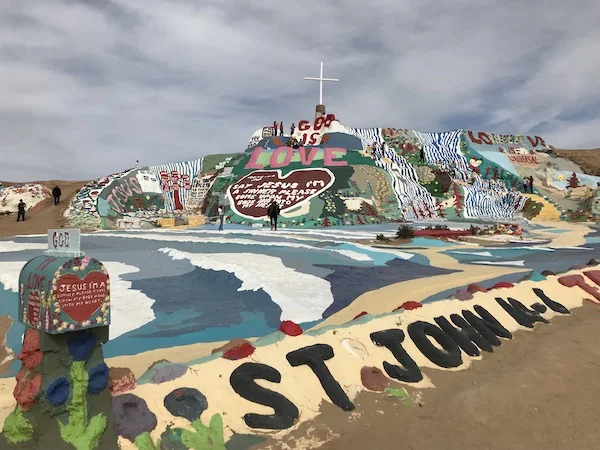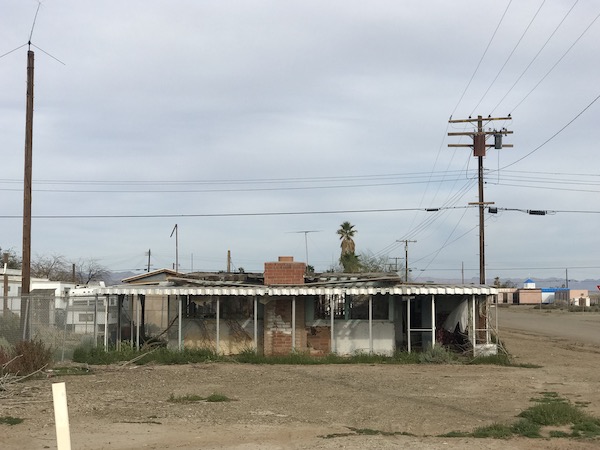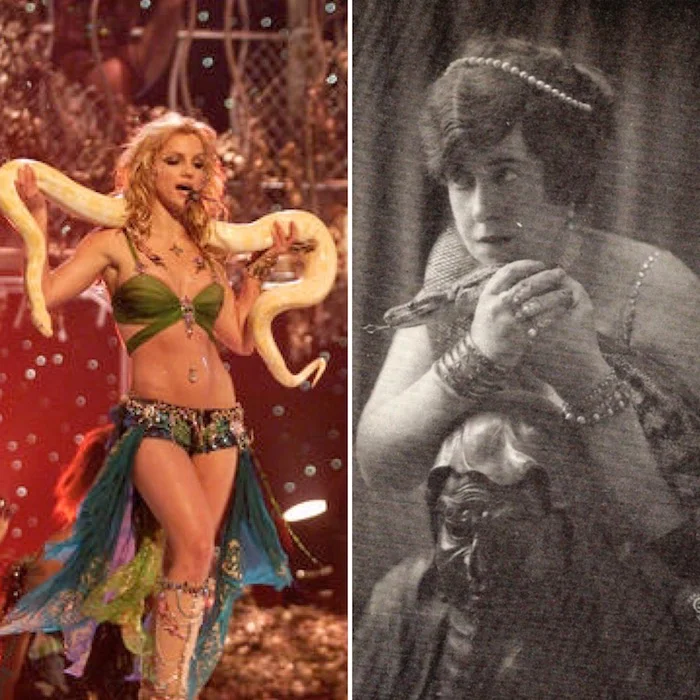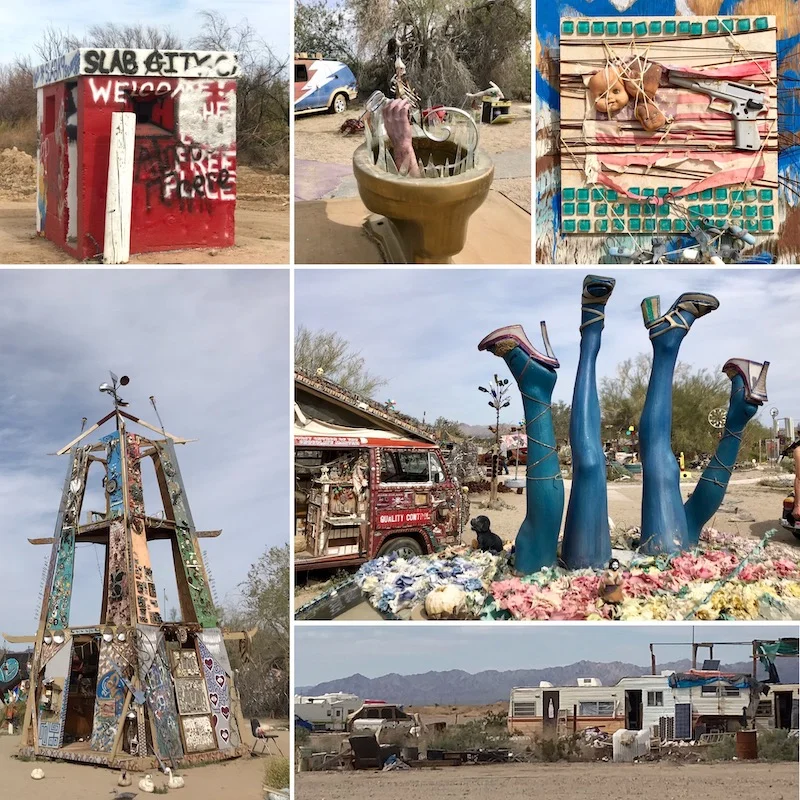A Day in the Desert, Part 3: Salvation and Resurrection
After exploring East Jesus a little bit, we drove back through Slab City to see Salvation Mountain (actually located near Slab City’s entrance, but we had decided to see the town in reverse) before heading to Bombay Beach.
Over three stories tall, this Technicolor folk art piece which could easily stand in as a set for Godspell or Jesus Christ Superstar was the vision of Leonard Knight, who came her e in the 1980s.
Leonard Knight photo:http://www.salvationmountain.us
Inspired to share the message “God is Love”, he planned on spending several weeks building a small monument to that effect. Fueled by his passion and sustained by his faith, the project stretched to months, then years. Built of straw mixed with adobe clay, dead trees scavenged from the desert, hay bales and old tires, Knight’s original vision eventually grewover fifty feet tall and 150 feet wide. Over 100,000 gallons of donated paint was used to weatherproof and decorate the mountain and neighboring museum.
After Knight died in 2014 at the age of 82, other artists have continued his work and visitors continue to bring cans of paint, which are vitally needed as Salvation Mountain requires constant patching and repainting in the harsh desert environment.
After exploring the labyrinthian interior of the museum
we climbed up the yellow brick road, past the River of Jordan, admiring the naif flowers along the way and feeling as if we were pieces in a Candyland board game come to life.
The view from the top not allowed allowed us to truly appreciate the scope of Knight’s work
It also let us get a birds eye view of Slab City
But the day was getting long, it was time to leave for our final stop of the day, Bombay Beach - a ghost town on the shore of the Salton Sea.
The Salton Sea is actually a lake forty miles long and over 13 miles wide, formed by accident in 1905 when the Colorado River overwhelmed irrigation controls in neighboring Arizona, and flooded over four hundred square miles of the low lying basin in which it sits.
The area was developed as a vacation destination after World War 2, with campgrounds, marinas and beach communities springing up along its shores.
Its heyday as a resort was short-lived, however. By the 1970s fertilizers, pesticides, salt and other agricultural pollutants from the irrigation run-off feeding the lake caused its salinity to spike, killing off most of the lake’s fish and making one big stink.
dead tilapia along the shore of Salton Sea photo: www.kpbs.org
The smelly beaches littered with fish carcasses or toxic muck kept away the tourists. Poor levee maintenance and fluctuations in the lake’s water levels flooded some areas while leaving others high and dry, creating dust storms that drove away many of the permanent residents who had remained. By the 2000s the landscape resembled some post-apocalyptic nightmare. The only visitors drawn to the abandoned homes (many with their former owners unwanted possessions still in them), rusting vehicles and derelict businesses of the half-empty ghost towns seemed to be filmmakers looking to shooting horror movies.
Then came social media. Haunting photographs taken of the desolation attracted adventurous types. They held their noses and took more photographs that appeared on blogs, online magazines, and instagram accounts. Word spread, and it became an offbeat destination for artists, intellectuals and hipsters seeking respite from the retro-glam of Palm Springs or the boho-chicness of Coachella roughly an hour away. A few of them stayed, bringing new life and energy to the place. By the time someone like me who is definitely on the dull side of the cutting edge hears of a place, chances are it has already been “discovered”.
We first went to the beach. While the dead fish carcasses are gone, pulverized into bits of calcium under the feet of tourists looking to snap that awesome photo of them, this half a lizard did the trick for me.
A door and mailbox to nowhere someone had put up struck an interesting note punctuated the view without detracting from it.
On our way back, remains of art installations from the town’s last Biennale stood to our right including the carcass of a wooden ghost ship.
It oddly seemed to balance the structural detritus of a former neighborhood destroyed by flooding then buried by sand quite well.
There are still a number of romantic abandoned and empty buildings about town to wander in and out of
although admittedly the interiors felt a bit curated.
In between them are faded homes of the old-time residents, a new opera house, and this museum which unfortunately was closed.
We went to the Ski-Inn (billed as the only place in town serving food and drink) and despite its faded sign, found it quite a rollicking place, filled with a lively mix of locals, newcomers and visitors.
We spoke to a man at the next table, who was in town creating a sculpture for the upcoming Bombay beach Biennale – he explained the festival was trying hard to stay under the radar for the time being, so as to not overwhelm things. Overall, it felt like Bombay Beach was achieving a very delicate balancing act between maintaining the spirit of the place while reinvigorating it. Bombay beach still has a sense of desolate beauty and decayed dreams, but it lacks the pathos it probably did ten or even five years ago (which isn’t necessarily a bad thing). Driving back towards Indian Wells, it appeared the whole lakeside region is in transition. Some buildings were still abandoned, but others sported fresh paint and people were using the lakeshore campgrounds. I am curious to see how the next few years treat the place.























